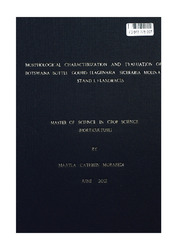| dc.description.abstract | Bottle gourd (Lagenaria siceraria Molina Stand1.) landraces are usually grown in Botswana under subsistence farming. Morphological characterization of the landraces is important to identify promising landraces for breeding, conservation and commercial farming. The main objective of the study was to characterise the bottle gourd landraces based on qualitative and quantitative traits. Five accessions, MBP025, MMB244, MBP026, MBP005, MBP052 were acquired through random selection from the National Plant Genetic Resources Centre (NPGRC) Gene Bank for the study. The study was conducted in Glen Valley farms in a Randomised Complete Block Design. Data was collected using the European Cooperative Programme for Plant Genetic Resource (ECPGR) descriptors for cucurbits. The results of the study showed that there were no significant differences in qualitative traits except for fruit shape, fruit neck, fruit color, fruit skin and seed color. The landraces showed significant differences in the quantitative traits except for peduncle length. The landrace MBP026 showed the highest recording for primary branches (26.91), vine length (6.65cm), internode length (26.13cm), fruit length (45.27cm), fruit diameter (26.33cm) fruit mass (1.02kg), seed length (18.11mm), yield per plant (11.37kg) and 100 seed weight (24.04g). MBP026 took longer time (12 days) to 50% emergence, less time (57 days) to first fruit harvest and was the least affected by Zucchini yellow mosaic virus (ZYMV).The cluster analysis based on 33 quantitative and qualitative characters at dissimilarity coefficient of approximately 1.28 separated the clusters into three groups. Cluster 2 was the major cluster which consisted of landraces MBP025, MBP052 and MBP005.Grouping was based on days to 50% germination, internode length, vine length, fruit colour, number of marketable fruits and peduncle length. MMB244 and MBP026 were separated into cluster 1 and 3, respectively. Three principal components accounted for 84.9% of the variation, and the morphological characteristics, which were significant for the principal components were mostly fruit related. The yield highly correlated positively with fruit mass, days to 50% flowering, number of seeds per fruit and weight of a hundred seeds. The evaluation of susceptibility and tolerance to diseases showed that MBP026 and MBP005 were moderately tolerant to Zucchini yellow mosaic virus (ZYMV); MMB244 was the most susceptible landrace which succumbed to Zucchini yellow mosaic virus and Watermelon mosaic virus (WMV) which consequently reduced its yield. The occurrence of ZYMV and WMV on Lagenaria siceraria is being reported for the first time in Botswana. Landrace MBP026 exhibited mostly desirable characteristics in the study therefore, it may be recommended for breeding and/or multiplication while MMB244 which was the least performing landrace could be improved to harness some of the desirable characteristics it displayed. Molecular characterisation of bottle gourd landraces should also be undertaken to lay foundation for other studies such as genetic improvement and agronomic evaluation to exploit potential of the crop. | en_US |

